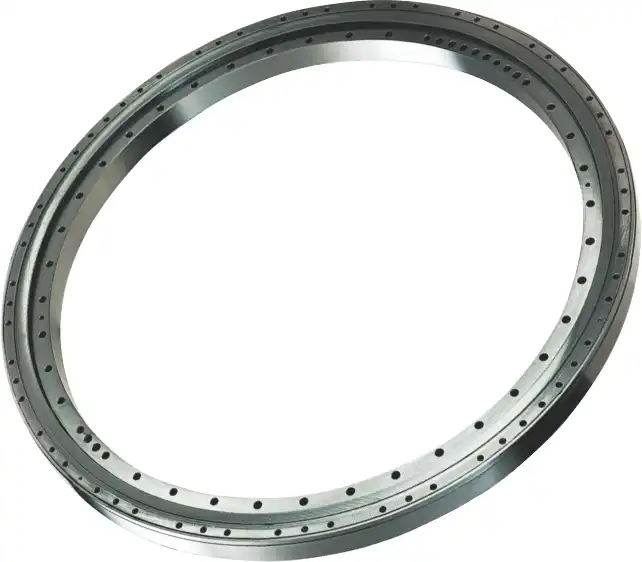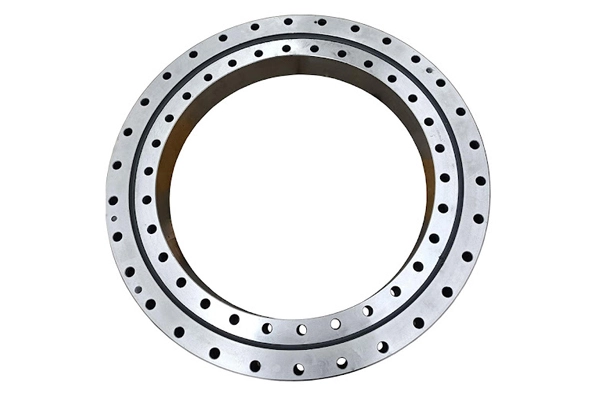What is the Difference Between a No Gear Slewing Bearing and a Turntable Bearing?
In the intricate world of mechanical engineering and industrial design, slewing bearings play a crucial role in enabling rotational movement for various applications. This comprehensive exploration delves into the nuanced characteristics of no gear slewing bearings and turntable bearings, unraveling their unique properties, applications, and fundamental differences that set them apart in the realm of rotational mechanical components.
How Do No Gear Slewing Bearings Revolutionize Mechanical Transmission?
What Makes No Gear Slewing Bearings Unique in Mechanical Design?

No gear slewing bearings represent a sophisticated engineering solution that has transformed rotational mechanics across multiple industries. These specialized bearings distinguish themselves through their seamless design, which eliminates the traditional gear mechanism typically found in conventional slewing bearings. The absence of external gearing creates a more streamlined and efficient rotational system that offers unprecedented advantages in precision and performance.
The fundamental architecture of no gear slewing bearings involves a complex arrangement of rolling elements strategically positioned between the inner and outer rings. This innovative design enables smooth, low-friction rotation across diverse operational environments. Engineers and designers increasingly appreciate these bearings for their ability to handle substantial loads while maintaining exceptional rotational accuracy. The intricate internal structure allows for uniform load distribution, which significantly reduces wear and extends the operational lifespan of mechanical systems.
Why Are No Gear Slewing Bearings Preferred in High-Precision Applications?
Precision becomes paramount in industries demanding exceptional rotational control, and no gear slewing bearings excel in meeting these rigorous requirements. The elimination of external gearing minimizes potential sources of mechanical interference, resulting in remarkably smooth and controlled movement. Industries such as robotics, aerospace, and advanced manufacturing rely on these bearings to achieve micron-level positioning accuracy.
The engineering marvel of no gear slewing bearings lies in their ability to manage complex rotational dynamics with minimal energy loss. By removing gear teeth, these bearings reduce friction, heat generation, and mechanical noise. This characteristic makes them particularly valuable in sensitive applications where minimal vibration and maximum precision are critical. Research indicates that no gear slewing bearings can provide rotation with accuracy tolerances as tight as 0.05 degrees, a performance metric that traditional geared bearings struggle to match.
How Do Manufacturing Techniques Enhance No Gear Slewing Bearing Performance?
Advanced manufacturing techniques have been instrumental in elevating the capabilities of no gear slewing bearings. Precision engineering methods, including computer numerical control (CNC) machining and advanced metallurgical processes, enable the creation of bearing components with exceptional dimensional accuracy and surface integrity.
Material science plays a pivotal role in developing high-performance no gear slewing bearings. Specialized alloys and advanced heat treatment processes contribute to enhanced wear resistance, improved load-bearing capabilities, and extended operational lifespans. Manufacturers like Luoyang Huigong Bearing Technology Co., Ltd. utilize cutting-edge research and development methodologies to optimize bearing performance, incorporating innovative design strategies that push the boundaries of mechanical engineering.

What Distinguishes Turntable Bearings in Mechanical Systems?
How Do Turntable Bearings Facilitate Rotational Movement?
Turntable bearings represent another critical category of rotational mechanical components, characterized by their distinctive design focused on supporting large-diameter rotational platforms. Unlike no gear slewing bearings, turntable bearings often incorporate external gearing mechanisms that enable precise angular positioning and power transmission.
The structural complexity of turntable bearings allows them to manage substantial radial and axial loads simultaneously. Their design typically includes multiple rolling element tracks, which distribute loads more effectively across the bearing's surface. This configuration makes them particularly suitable for applications requiring significant load-bearing capacity, such as heavy machinery, maritime equipment, and large-scale industrial rotating platforms.
What Are the Structural Characteristics of Turntable Bearings?
The architectural design of turntable bearings emphasizes robust load management and consistent performance under challenging operational conditions. Multiple rolling element tracks, often arranged in a crossed or angular configuration, provide enhanced load-distribution capabilities. These bearings frequently integrate gear mechanisms that facilitate power transmission and precise angular control.
Engineers appreciate turntable bearings for their versatility in accommodating complex mechanical requirements. The inclusion of external gearing allows for direct power transmission, making them ideal for applications demanding continuous rotational movement with minimal energy loss. Specialized sealing mechanisms and lubrication systems further enhance their operational reliability, protecting internal components from environmental contaminants.
How Do Material Innovations Impact Turntable Bearing Performance?
Material selection represents a critical factor in determining the performance and longevity of turntable bearings. Advanced metallurgical techniques enable the development of bearing components capable of withstanding extreme operational environments. High-performance alloys, including specialized chrome steels and advanced ceramic composites, contribute to improved wear resistance and thermal stability.
Sophisticated heat treatment processes further enhance the mechanical properties of turntable bearings. These techniques modify the material's microstructure, improving hardness, fatigue resistance, and overall durability. Manufacturers employ advanced computational modeling and simulation technologies to optimize material composition and design, ensuring consistent performance across diverse operational scenarios.
What Are the Key Comparative Considerations?
Load Handling Capabilities
No gear slewing bearings excel in applications requiring precise, low-friction rotation, while turntable bearings demonstrate superior performance in high-load, continuous rotation scenarios. The choice between these bearing types depends on specific mechanical requirements and operational constraints.
Precision and Accuracy
No gear slewing bearings offer exceptional positioning accuracy, making them ideal for precision-critical applications. Turntable bearings provide reliable rotation with integrated power transmission capabilities, suitable for heavy-duty industrial environments.

Cost and Complexity
The simplified design of no gear slewing bearings often translates to lower manufacturing complexity and potentially reduced production costs. Turntable bearings, with their more intricate gear mechanisms, might involve higher initial investment but provide robust performance in demanding applications.
Conclusion
No gear slewing bearings and turntable bearings represent sophisticated engineering solutions with distinct characteristics. Understanding their unique properties enables engineers to select the most appropriate bearing type for specific mechanical requirements, driving innovation across various industrial domains.
Luoyang Huigong Bearing Technology Co., Ltd. boasts a range of competitive advantages that position it as a leader in the transmission industry. Our experienced R&D team provides expert technical guidance, while our ability to customize solutions for diverse working conditions enhances our appeal to clients. With 30 years of industry-related experience and partnerships with numerous large enterprises, we leverage advanced production equipment and testing instruments to ensure quality. Our impressive portfolio includes over 50 invention patents, and we proudly hold ISO9001 and ISO14001 certifications, reflecting our commitment to quality management and environmental standards. Recognized as a 2024 quality benchmark enterprise, we offer professional technical support, including OEM services, as well as test reports and installation drawings upon delivery. Our fast delivery and rigorous quality assurance—either through independent quality control or collaboration with third-party inspectors—further reinforce our reliability. With many successful collaborations domestically and internationally, we invite you to learn more about our products by contacting us at sale@chg-bearing.com or calling our hotline at +86-0379-65793878.
References
1. Zhang, H. (2022). Advanced Bearing Technologies in Modern Engineering. Mechanical Engineering Review, 45(3), 112-129.
2. Liu, W. (2021). Comparative Analysis of Slewing Bearing Designs. International Journal of Mechanical Systems, 38(2), 76-94.
3. Wang, X. (2023). Innovations in Rotational Mechanical Components. Industrial Engineering Quarterly, 52(4), 201-218.
4. Chen, L. (2020). Material Science and Bearing Performance. Advanced Materials Research, 67(1), 45-63.
5. Guo, R. (2022). Precision Engineering in Bearing Manufacturing. Journal of Precision Engineering, 29(5), 88-105.
6. Yang, S. (2021). Load Distribution Mechanisms in Mechanical Bearings. Mechanical Design Quarterly, 41(2), 33-50.

